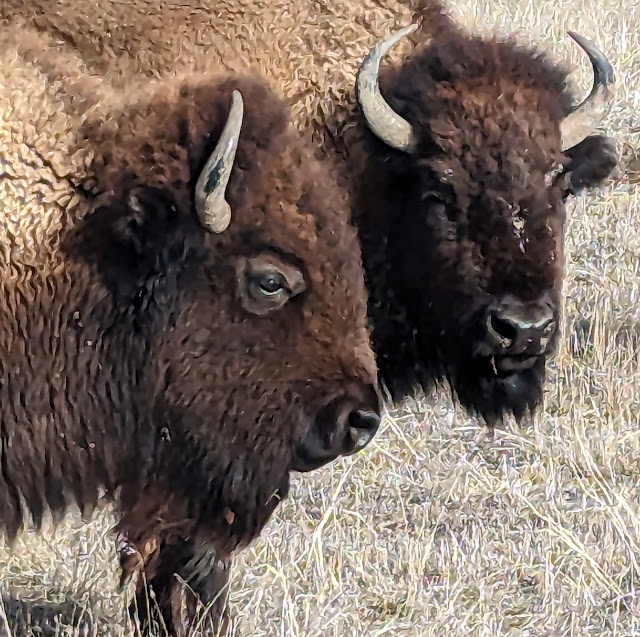It was all their idea, but I wasn't in a position to decline the invitation. Few things in life are as compelling as a trip out west, even if you already know the stories and are in charge of telling them. And, truth be told, there's so little most of us really know about our Native neighbors and their stories. So, "Yes, I'll do it," I told them, when they asked.
"What about weather?" they said.
"Maybe you ought to think about waiting until fall," I told them. Farch is farch, and, if nothing, unpredictable.
"This is the only time we can make the trip," they said, "so let's."
It was cold, winter cold--15 degrees or so. Some wind, but any wind at all when the temps are baseline is not going to be comfy. So when I took them down 20 miles of gravel to a spot high above the Santee Reservation, it wasn't fun to be so thusly exposed. We couldn't get into the Santee Museum (out of season), so things had to be explained outside. We made it.
Then down to the river and out to a Mormon monument, set there by the LDS to preserve the memory of the Saints who'd wintered there and some who died, that number drastically reduced by the salvation the Ponca offered them--food and supplies to keep them alive.
Then, the Ponka cemetery, like all others, offers its own stories. It was bitterly cold out there, but lots of our Saints even ascended the hill to read the graves.
On to Greenwood, mostly a ghost town, where Lewis and Clark, the story goes, wrapped a brand new Yankton baby in an American flag and declared him a man who would bring peace to his people, which he was and did, after a fashion. Then Marty, St. Paul's cathedral an amazing dream in an otherwise nearly empty prairie landscape.
A stop at New Holland CRC, a museum of its own, then finally a long, cold day ended in Platte, at a motel with a pizza place conveniently next door.
The most amazing thing happened the next day when, unannounced, spring arrived. Chamberlain's Akta Lakota Museum was a wonder, as it always is, as was a tour of St. Joseph's Indian School (a first for me). We ate at Al's Oasis, then pointed the van west, drove for an hour, got out at a rest stop, and were blessed--seriously blessed--by windless 65-degree temperatures. It was, if I dare say it, a touch of heaven, almost unbelievable, almost miraculous. We'd climbed 50 degrees up the thermometer. Stayed, that night, in Wall--where else, of course?--and experienced a unique phenomenon, unknown to the millions who journey west--Wall, South Dakota with zero tourists, Main Street all but barren, if you can believe it.
After taking the Badlands loop the afternoon before, we followed the southwest range of the Badlands, all of it dressed in garlands of snow, and even ran into buffalo--well, avoided them, but stopped for some portraits. For most of the morning we were pretty much alone in miles and miles of reservation, until we came to a much hoped-for convenience corner, where it became apparent immediately that masking was, if nothing else, obligatory--thus saith the tribe. Later, we wore them again in a Subway in Pine Ridge, a joy.
Drove on to Wounded Knee, always an experience for those who've never been there. Spring had lingered graciously for another day, so if we sidestepped the mud we could climb up to the place where the chapel once stood (during the 1973 takeover), the place where the 7th Cavalry set up their Hotchkiss gun to reign terror on Big Foot's people.
A couple of artists stopped by and sold a few souvenirs of the visit, the kind of footnote that makes the text come alive.
We stopped by several cemeteries in four days, but Wounded Knee--a killing field--stops your breath like no other.
Got back in the bus, headed west to Ft. Robinson, from whence the cavalry had come in 1890, before Wounded Knee, heard some Ft. Rob stories, then stayed overnight in Chadron in a fine motel with yet another restaurant right next door--and, oh yes, spring had somewhat coldly departed.
What most of the travelers won't forget is brutal wind and cold and snow that attacked all the way back to Yankton. Had our fearless driver not engineered trips out of the ditch, we'd likely be there still. Twisters of snow in monster winds created a ground blizzard unlike anything the pilgrims had ever seen and hope never to experience again.
But all's well that ends well, and this weary traveler had his feet up at home in Alton, when a couple of emails came in indicating everything post-South Dakota was a piece of cake for the others. Pella must have looked beautiful when it appeared at sunset.
That's where I was this week with some joyous adventurers from Pella's 2nd Reformed Church, a few pioneers who wanted to know more about Native American history. They got an earful--and more--in a bit of winter, two days of spring, and a monster ground blizzard, four days of Farch in Nebraska and South Dakota.
I loved it, as I believe they seemed to also.



1 comment:
Jim, it was a trip of epic memories. We have renamed the van "Stays Out of Ditch!" We can't thank you enough for making these places and their history come alive for us. I come away wanting to read and learn more. Thank you!
Post a Comment